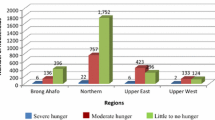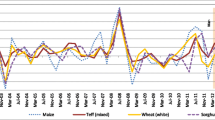Abstract
The food security literature has reiterated the importance of having an indicator that simultaneously captures the different dimensions of the food security definition. In this regard, this study builds on previous studies using a harmonized food security indicator within a relatively high frequency panel data from Rwanda to examine the dynamics of household food security. Summary statistics show the transitory nature of food security where households go either from complete state of food insecurity to being partially food insecure or from being partially food insecure to being completely food secure during the harvesting seasons and later fall back to their initial state during the sowing and growing seasons. This underscores the intertemporal dimension and transitory nature of food security over time. We also employed a correlated random effects multinomial logit model to further identify the determinants of households being in any of the identified states of food security. Results suggest that agricultural seasons of major food crops do determine households’ state of food security. Also, household socio-demographic characteristics, household assets, income diversification, and location of the household dwelling are some of the consistent factors that increase or decrease the likelihood of the household being food insecure.
Similar content being viewed by others
Notes
Gauss-Hermite quadrature is a form of Gaussian quadrature for approximating values of integrals
Based on the data description, we believe that the first visit in this round was conducted in October 2013 and subsequent questions about consumption were related to the previous visit. An example of such question is: “How much was spent on a particular type of food since my last visit”. Thus, we can imply that the collection of food consumption data did not start until November. It is important to also note that each period varies from household to household because households were randomly assigned cycle numbers between 1 to 10 such that the data of each period was obtained from the participating households in 10 cycles. However, the intervals between cycles are predetermined. Thus, data on each period are obtained within a time interval.
In each district, the EAs are stratified based on urban and rural strata and are ordered first by urban, semi-urban, peri-urban, and rural, and subsequently geographically according to sector, cell, village, and the EA codes.
Temporary workers are workers that have fixed-term contract with their employer.
In the questionnaire used to obtain the data, there is a question on what percentage of the profit from the business belongs to the household.
Dependency ratio is the ratio of children below the age of 15 and the elderly who are above 64 years to the household size. Age 15 to 64 is considered the active or working class
The aggregation of both produced and purchased food in the calculation of food expenditure per capita suggests that our food expenditure indicator has some elements of food availability imbedded in it.
We treated these households as incomplete data because there is no way, no matter how little that a household will not incur expenditure on perishable food items within the space of about a month
We made use of the FAO food group classification specified in the guidelines for measuring household and individual dietary diversity. However, we merge some food classes like meat and fish because they are substitutes.
Some information about the agricultural seasons of major food crops can be found at this FAO website link. http://www.fao.org/giews/countrybrief/country.jsp?code=RWA
As stated in footnote 5, the data for each period is obtained from the household over 10 cycles and based on the data description, there was an initial visit in October against which subsequent data on consumption and expenditure data were collected. Thus, we assume that data collection on food consumption and expenditure did not start until November. Since the data was collected over a 12-month period and the first month was an initial visit, our best guess was to divide the remaining 335 days of the year into 10 to give us an idea of what each period of data is likely to be. It is based on this calculation that we constructed the agricultural seasonal dummies for major food crops.
Kindly note that the seasonal dummies are not mutually exclusive because they do overlap. For example, the growing season B for Maize and Sorghum overlaps with the harvesting season A of beans. More information can be found at http://www.fao.org/giews/countrybrief/country.jsp?code=RWA
These major food crops include beans, maize and sorghum. More information can be found at http://www.fao.org/giews/countrybrief/country.jsp?code=RWA
Page 16 of Horticulture and floriculture in Rwanda presents a table for the production schedule for tomato. The document can be obtained from http://edepot.wur.nl/370322
References
Arimond, M., & Ruel, M. T. (2004). Dietary diversity is associated with child nutritional status: Evidence from 11 demographic and health surveys. The Journal of Nutrition, 134(10), 2579–2585.
Carletto, C., Zezza, A., & Banerjee, R. (2013). Towards better measurement of household food security: Harmonizing indicators and the role of household surveys. Global Food Security, 2(1), 30–40.
Deaton, A. (2010). Price indexes, inequality, and the measurement of world poverty. The American Economic Review, 100(1), i-34.
Food and Agriculture Organization. (1996). Rome declaration on world food security and world food summit plan of action: World food summit 13–17 November 1996, Rome. FAO: Italy.
Gabbert, S., & Weikard, H. P. (2001). How widespread is undernourishment? A critique of measurement methods and new empirical results. Food Policy, 26(3), 209–228.
Gönül, F., & Srinivasan, K. (1993). Modeling multiple sources of heterogeneity in multinomial logit models: Methodological and managerial issues. Marketing Science, 12(3), 213–229.
Haan, P., & Uhlendorff, A. (2006). Estimation of multinomial logit models with unobserved heterogeneity using maximum simulated likelihood. The Stata Journal, 6(2), 229–245.
Headey, D. D., & Ecker, O. (2012). Improving the measurement of food security. IFPRI Discussion Paper 1225. Washington, D.C.: International Food Policy Research Institute (IFPRI). http://ebrary.ifpri.org/cdm/ref/collection/p15738coll2/id/127261. Accessed 23 October 2017
Hendriks, S. L., & Msaki, M. M. (2009). The impact of smallholder commercialization of organic crops on food consumption patterns, dietary diversity and consumption elasticities. Agrekon, 48, 184–199.
Hussein, F. M., Ahmed, A. Y., & Muhammed, O. S. (2018). Household food insecurity access scale and dietary diversity score as a proxy indicator of nutritional status among people living with HIV/AIDS, Bahir Dar, Ethiopia, 2017. PLoS One, 13(6), e0199511.
Ike, C. U., Jacobs, P. T., & Kelly, C. (2017). A multidimensional approach to measuring household food security in Taraba state, Nigeria: Comparing key indicators. Development in Practice, 27(2), 234–246.
Jain, D. C., Vilcassim, N. J., & Chintagunta, P. K. (1994). A random-coefficients logit brand-choice model applied to panel data. Journal of Business & Economic Statistics, 12(3), 317–328.
Magrini, E., & Vigani, M. (2014, August). Technology adoption and the multiple dimensions of food security: The case of maize in Tanzania. In 2014 International Congress, August 26-29, 2014, Ljubljana, Slovenia (No. 182646). European Association of Agricultural Economists.
McFadden, D. (1974). The measurement of urban travel demand. Journal of Public Economics, 3(4), 303–328.
Melgar-Quinonez, H., & Hackett, M. (2008). Measuring household food security: The global experience. Revista de Nutrição, 21, 27s–37s.
Nubé, M. (2001). Confronting dietary energy supply with anthropometry in the assessment of undernutrition prevalence at the level of countries. World Development, 29(7), 1275–1289.
Ogundari, K. (2017). Categorizing households into different food security states in Nigeria: The socio-economic and demographic determinants. Agricultural and Food Economics, 5(1), 8.
Pinstrup-Andersen, P. (2009). Food security: Definition and measurement. Food security, 1(1), 5–7.
Revelt, D., & Train, K. (1998). Mixed logit with repeated choices: households' choices of appliance efficiency level. Review of Economics and Statistics, 80(4), 647–657.
Ruel, M. T. (2003). Operationalizing dietary diversity: A review of measurement issues and research priorities. The Journal of Nutrition, 133(11), 3911S–3926S.
Smith, L. C., & Subandoro, A. (2007). Measuring food security using household expenditure surveys (Vol. 3). Intl Food Policy Res Inst.
Svedberg, P. (2002) Undernutrition Overestimated. Economic Development and Cultural Change 51(1):5–36
Tambi, E., Aromolaran, A., Odularu, G., & Oyeleye, B. (2014). Food sovereignty and food security: Where does Africa stand? Forum for agricultural research in Africa (FARA). Ghana: Accra.
Upton, J. B., Cissé, J. D., & Barrett, C. B. (2016). Food security as resilience: Reconciling definition and measurement. Agricultural Economics, 47(S1), 135–147.
Webb, P., Coates, J., Frongillo, E. A., Rogers, B. L., Swindale, A., & Bilinsky, P. (2006). Measuring household food insecurity: Why it's so important and yet so difficult to do. The Journal of Nutrition, 136(5), 1404S–1408S.
Author information
Authors and Affiliations
Corresponding author
Ethics declarations
Conflict of interest
The authors declare that they have no conflict of interest.
Appendix
Appendix
Rights and permissions
About this article
Cite this article
Bolarinwa, O.D., Ogundari, K. & Aromolaran, A.B. Intertemporal evaluation of household food security and its determinants: evidence from Rwanda. Food Sec. 12, 179–189 (2020). https://doi.org/10.1007/s12571-019-00986-z
Received:
Accepted:
Published:
Issue Date:
DOI: https://doi.org/10.1007/s12571-019-00986-z




